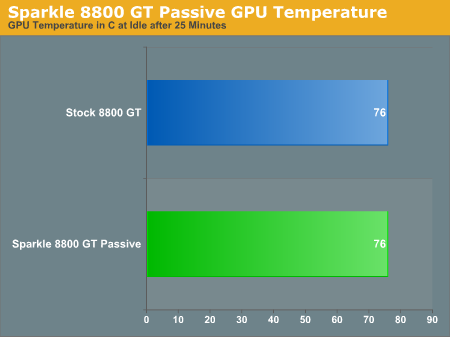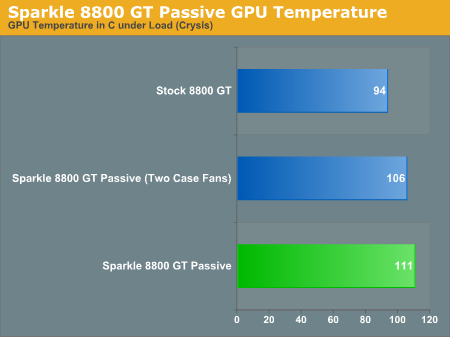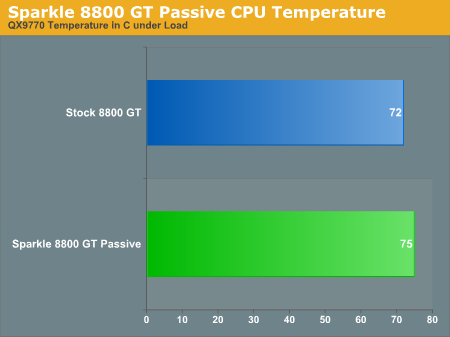Sparkle 8800 GT Passive: The Fastest Silent GPU in the World
by Anand Lal Shimpi on November 29, 2007 12:00 AM EST- Posted in
- GPUs
Once again, Crysis was our benchmark of choice as it seems to put the greatest stress on GPUs. We played for hours on end until the GPU temperature leveled off, using nTune to monitor temperature levels from the GPU's on-die thermal diode. Note that playing Crysis actually got these GPUs hotter than looping the 3DMark '06 HDR/SM3 tests, although only by 1 - 2C.

Interestingly enough, at idle, both the stock 8800 GT with its fan and the Sparkle passive card reach about 76C. The only explanation is that the 8800 GT's fan is designed to remain as quiet as possible, so it doesn't actually do all that much cooling when the GPU isn't being stressed.

Running Crysis, the stock 8800 GT's GPU peaks at around 94C with the two 80mm case fans in the system unplugged. The passively cooled Sparkle in the same situation is already at 111C, an increase of 17C, not nearly as much as we honestly expected but still quite hot.
Turning the case fans on drops the GPU temperature to 106C, showing that airflow in the chassis is important.

The impact on CPU temperature was actually marginal, the hottest of the four cores of the QX9770 only saw a 3C increase in core temperature.
Despite our best efforts, the Sparkle 8800 GT Passive prevailed, although posting some worryingly high GPU temperatures the card never crashed during our tests.










55 Comments
View All Comments
qamca - Sunday, January 20, 2008 - link
Well, it occurs to me that the authors of this article have no intention on getting the coolest, but in somewhat beating the record of highest temperature out of this configuration....And if your PC case is so small and in such a mess and so crowded, I don't see why would anyone buy a passive cooled performance graphics card like this one... In fact I don't see why would anyone build any performance configuration in a case like this one??
Another test I read has successfully overclocked this card to 695/2000 without reaching 85C.
All you need is a tidy case and a well thought trough airflow in it.
So keep your pants on all you people scared of getting burned...
jay401 - Saturday, December 8, 2007 - link
"NVIDIA’s original target for the 8800 GT was $199 for the 256MB version and $249 - $259 for the 512MB version,"WHOAH WHOAH WHOAH. In your original review article, about the 512MB model, you said you expected prices would be $200-250 for the card. And in reality the 512MB WERE available for as low as $219 on launch day. So bullcrap to this revisionist "$249-259 for the 512MB version".
Nice attempt at trying to re-write history though. I'm sure NVidia appreciates it.
The reality is the reference design 512MB models were to be available as low as $200 (and we saw deals as low as $209 crop up within the first two weeks after launch). It was the over-clocked models that would approach $250-260 on the high end.
zshift - Monday, December 3, 2007 - link
google 111 c in f and you'll see that the card is running at 231.8 F. water boils at 212 F/100 C. that means you should never handle that card immediately after playing a game (i.e., u play a game, shut down pc, then switch out components, cards, etc.), or else you'll be holding a blistering hand, literally. so be careful out there if you buy this card.natrap - Wednesday, December 5, 2007 - link
111C is the temperature at the GPU where the sensor is located. The temperature on the surface of the card and the heatsink will be somewhat lower.BucDan - Saturday, December 1, 2007 - link
Sparkle is so bs to me..that cooler looks exactly like a thermalright hr-01 seriously... at least its not lke the hr-03/r600 lol...what losers gotta copy thermalright with their ideas.natrap - Saturday, December 1, 2007 - link
sorry for the multiple posts. silly thing kept spitting out error so it didn't look like it posted.natrap - Saturday, December 1, 2007 - link
I agree with Cerb. The fact that it reached 111C and did not fail is a good sign. And that was recorded with the case fans off in a poorly ventilated case. I'm gonna get this for an Antec Solo which has a single 120mm case fan at the rear over the CPU. I'd expect a temp a little lower. As for such high temps affecting the life of the card, well it does come with a 12 month warranty. If it hasn't failed in that time running close to 24/7 then the chance of it failing soon after isn't going to be a great deal higher.Cerb - Saturday, December 1, 2007 - link
If you want to add a fan, just get another card. The idea of a passive card is that your case can sufficiently move air to cool it, without adding another noise-maker.They put this GPU in a scenario that would be insane for anyone to actually try, and it DID NOT FAIL. In a decent case, with decent air flow and cable management, it should work excellently, without any modding.
Sure, you can get an aftermarket cooler and cool it better. In fact, you can probably do better passive, with something like the S1. But, that means more work, and more cost. Adding a fan, however good it cools it, basically defeats the purpose, though.
natrap - Saturday, December 1, 2007 - link
I agree with Cerb. The fact that it reached 111C and did not fail is a good sign. And that was recorded with the case fans off in a poorly ventilated case. I'm gonna get this for an Antec Solo which has a single 120mm case fan at the rear over the CPU. I'd expect a temp a little lower. As for such high temps affecting the life of the card, well it does come with a 12 month warranty. If it hasn't failed in that time running close to 24/7 then the chance of it failing soon after isn't going to be a great deal higher.natrap - Saturday, December 1, 2007 - link
I agree with Cerb. The fact that it reached 111C and did not fail is a good sign. And that was recorded with the case fans off in a poorly ventilated case. I'm gonna get this for an Antec Solo which has a single 120mm case fan at the rear over the CPU. I'd expect a temp a little lower. As for such high temps affecting the life of the card, well it does come with a 12 month warranty. If it hasn't failed in that time running close to 24/7 then the chance of it failing soon after isn't going to be a great deal higher.